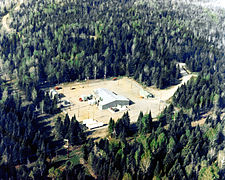
Communication with submarines is difficult because radio waves do not travel well through good electrical conductors like salt water.
The obvious solution is to surface and raise an antenna above the sea level, then use ordinary radio transmissions. However, a submarine is most vulnerable when on the surface. Early submarines mostly travelled on the surface, diving mainly to evade immediate threats because of their limited underwater speed and endurance. During the Cold War, however, nuclear-powered submarines were developed that could stay submerged for months. To communicate with submerged submarines several techniques are used.
Sound travels far in water, and underwater loudspeakers and hydrophones can cover quite a gap. Apparently, both the American (SOSUS) and the Russian Navy have placed sonic communication equipment in the seabed of areas frequently traveled by their submarines and connected it by underwater communications cables to their land stations. If a submarine hides near such a device, it can stay in contact with its headquarters. An underwater telephone sometimes called Gertrude is also used to communicate with submersibles.